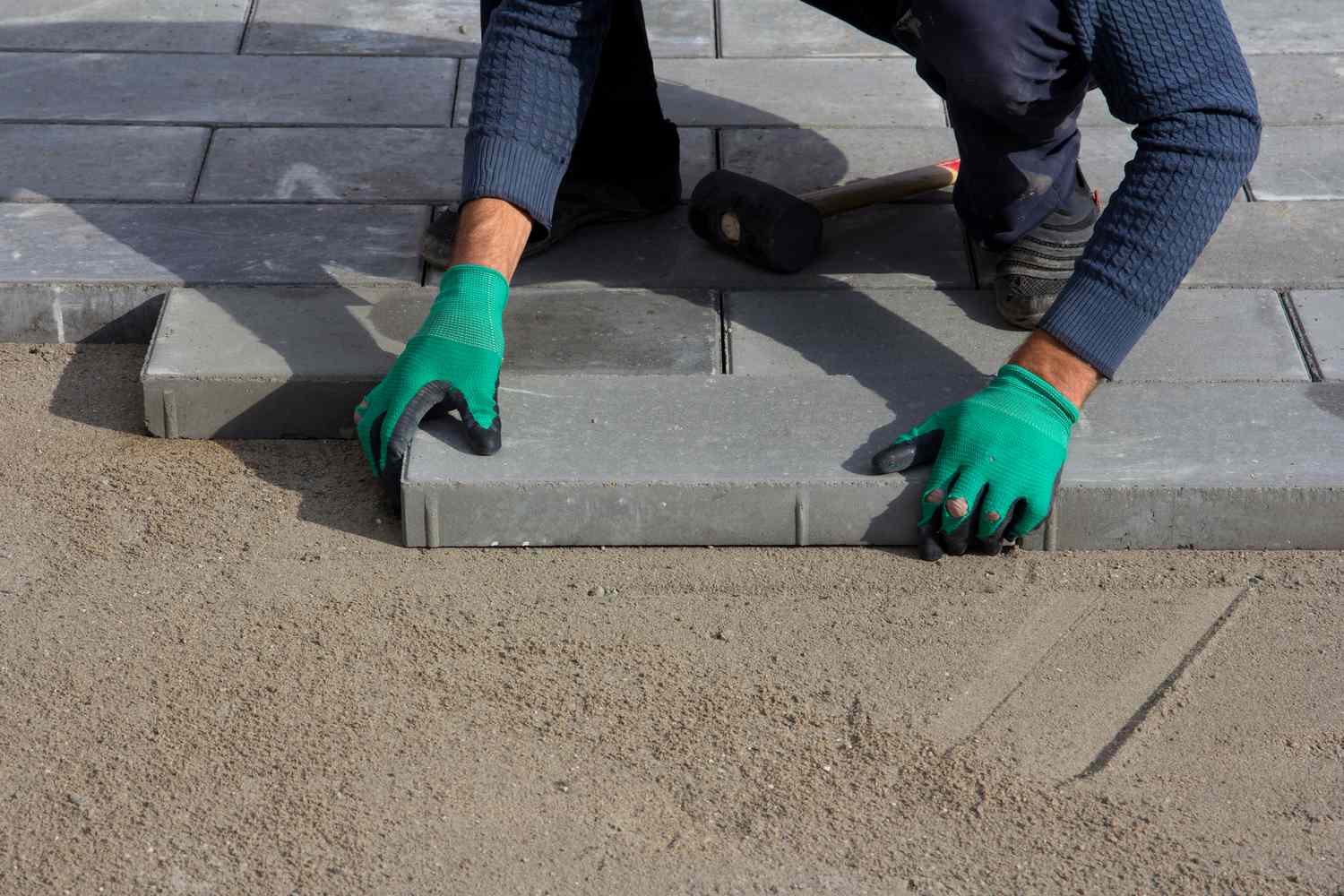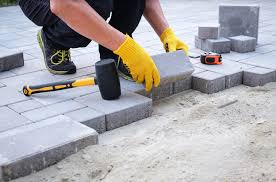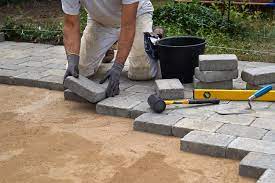10 Ways On How To Lay Pavers

Ways On How To Lay Pavers; Looking to add a sturdy driveway, a charming walkway, or an eye-catching patio to your property? If you’re reading this, you’re probably already moving on the right path. Paving stones made of concrete or brick can improve the appearance of any yard.
They are strong and flexible and can be tailored to be as dramatic or modest as you like. Even installing them is easy! Okay, sort of. Even though it takes time, planning, and work to carefully lay pavers, it is achievable and will save you money.

The steps on How To Lay Pavers, whether they are made of brick, concrete, or stone, should be helpful. It is a good idea to be familiar with the procedure even if you intend to have your pavers professionally installed.
We’ll go over each of the ten steps below in detail:
1. Planning and Layout
2. Calculating Amount of Pavers Needed
3. Excavation
4. Base Material
5. Edge Restraints
6. Sand Bedding
7. Laying Pavers
8. Sand Joints
9. Sealing
10. Maintenance
Read Also; How to Make Atmosphere in Little Alchemy 2
1. Ways On How To Lay Pavers: Planning and Layout
You should start by planning the area that will be paved. Choose where you want to place your pavers and assess the available space. Utilizing graph paper and measuring tools, you can create your plan.
Create the outline of your paved area by laying out your planned area using a hose or a piece of wood.
The next step is to mark or spray-paint the outline eight inches outside of it. EnoughInfo.Com
To prevent water from pooling or ponding and causing long-term damage to the pavement, keep in mind that the area needs to be sloped or gradient so that water can run off the pavers.
2. Methods For Laying Pavers: Calculating Amount of Pavers Needed
The area that needs to be paved should first be measured in width and length. The breadth is then multiplied by the length. You may calculate the area that has to be paved using the result.
Always add 5% to this estimate to account for pavers that will need to be cut to accommodate curves and odd-shaped spaces.
You should increase the amount by 10% if you anticipate cutting a lot of pavers.
After that, multiply the area’s square footage by the paver coverage rate, which can be received from your provider. This pricing varies according to the paver’s size and form.
3. Ways On How To Lay Pavers: Excavation
Decide on the height the pavers should reach and not rise above.
Keep in mind that the slab must slope downhill and away from the house to allow for water drainage. You need to incline down one inch every four feet.
Stakes should be placed all around the parameter, with the slope decline marked on the stakes.
Put a string in a tight knot on the stakes to mark the next height level.
Determine the required excavation depth overall. To do this, add the thickness of the paver to the inches needed for the base (4 to 6 inches), the sand bedding (1 inch), and the bedding thickness. You will then have the necessary excavation depth. Dig to the appropriate depth, level the earth, and use a compacting machine to compact it. How to Build Healthy Bones (Top Strategies: 2023)
After the excavation is finished, it is advised to create a temporary boundary for rectangular areas using 2 x materials that are put at the right height and slope.
Read Also; 22 Fast Home Remedies to Get Rid of a Cough

4. Methods For Laying Pavers: Base Material
The next step is to lay the base material when the excavation is finished.
Crushed rock, such as 3/4-minus gravel, typically makes up the base material.
Different-sized stones with sharp edges make up the crushed rock. It is simple to compact due to the sharp edges and size variation. Compaction is greatly facilitated by using crushed gravel that has a small amount of moisture in it.
The sub-base material and the weight that will be placed on the paved area will determine the thickness of the base material that is appropriate for the intended use. A thicker layer will be necessary if your sub-base is soft clay. A thicker layer than what is required for a patio will be required if the pavers are to be driven on. For recommendations, ask your supplier. How to Stay Focused (Steps and Requirements)
In a uniform layer, cover the area with crushed gravel.
It is advised that you condense between each layer and divide it into three smaller layers for the best effects. Use a plate compactor to repeatedly go over the area after it has been uniformly distributed. Ensure that the compacted gravel is sloped, level, and at grade with your chosen height.
Read Also; How to do Crunches (Step-by-Step Guide 2023)
5. Edge Restraints
The maintenance of your pavement surface requires edging. Your pavers will slide and split if edge restraints are not placed. Your paved surface will become damaged due to severe weather, heavy traffic, and an absence of edge restrictions. The materials for edge restraints include plastic, aluminum, pre-cast concrete, and wood.
6. Sand Bedding
The compacted base material is covered with a layer of bedding sand before the pavers are laid. This layer acts as a foundation for the paver installation. Additionally, the sand bedding contributes to preventing erosion of the sand joints.
Cross the bass material with a piece of PVC pipe with an inch diameter.
Sand should then be spread in a layer that is between one and one and a half inches thick. The PVC piping can now be seen by screeding the sand with a 2 x 4 to expose it. Take care when removing the PVC pipe. This method guarantees a layer of sand that is one inch thick and uniform.
Your material supplier can offer guidance on the right kind of sand to use for bedding purposes.
Read Also; How To Make Quesadilla ( Step by Step Methods)
7. Laying Pavers
Lay the pavers out according to your planned pattern and layout. Put them together closely. A few types of pavers include space bumps in their design. Use a diamond saw, masonry chisel, mechanical splitter, and safety goggles to cut pavers to size if necessary.
After all of the pavers have been laid, compact them into the sand bedding using a mechanical plate compactor.https://enoughinfo.com/how-to-lay-pavers
8. Sand Joints
Sand is spread over the surface in this step, filling in the gaps between the pavers and securing them in place.
Using fine-grained sand as opposed to coarse-grained sand is crucial. Play sand that has been sifted and bagged works well, as does sand referred to as “paver sand.” This is due to the fact that fine sand will fill joints more quickly and compact significantly better. To complete this step, the paver and sand area needs to be dry.
9. Methods For Laying Pavers: Sealing
In order to fill in the joints and secure the pavers in place, this step involves sweeping sand over the ground.
Instead of coarse sand, it’s crucial to use fine-grained sand. Play sand that has been sifted and packaged well also works well. Fine sand will compact significantly better and fill joints faster, which is the reason for this. For this step to be completed, the paver and sand area must be dry.
Read Also; How To Stop Drinking Alcohol ( Step- by Step- Guide )
10. Maintenance is important in Laying Pavers
If pavers have been installed properly, maintenance is typically not a problem.
Your paved surfaces should perform and be used consistently as a whole.
To keep your pavers’ color and appearance, you might need to reseal them periodically.
It is advised to sweep and clean the pavers frequently.
This is especially important if your pavers are located in damp or dark places because these conditions make them vulnerable to moss growth and efflorescence (chalky salt deposits).
Power washing is normally not recommended because it will disturb the joint sand. After power cleaning, steps 8 and 9 should be repeated.
There are several cleaning products available on the market that can be utilized in a number of situations.
Conclusion
Pavers, usually referred to as paving stones, are flat chunks of concrete, stone, or brick that exactly fit together to build structures like driveways, patios, and pathways. Pavers are a popular material for landscaping home improvements because they are reasonably priced and simple to install at many home improvement stores. Before you begin laying pavers, make sure your space is precisely measured and prepared to ensure that your finished project is both aesthetically pleasing and functional.




